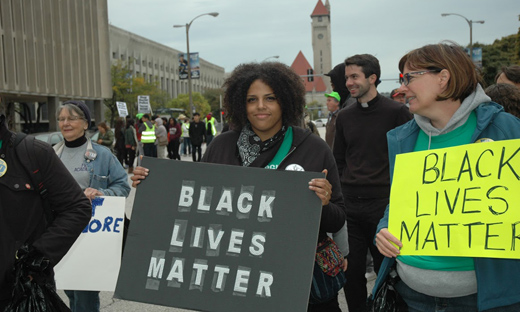
ST. LOUIS – It has been roughly 80 days since the tragic and criminal killing of Mike Brown, an African American teenager who had recently graduated from high school and was about to start college.
Brown was shot to death by Darren Wilson, a white Ferguson, Missouri police officer, while – as eye witnesses claim – attempting to surrender with his hands up.
Since Mike Brown’s killing on Aug. 9, thousands of protesters – local, regional, and national – have shined a much-needed spotlight on the life and death consequences of police brutality and violence directed largely at men of color.
Protesters have also brought to the foreground the militarization of our neighborhoods and the unwarranted, unjustified misuse of police force that has literally taken aim at our constitutional right to peacefully assemble. Furthermore, the use of rubber bullets, tear gas, percussion grenades, pepper-spray and police batons specifically and overwhelmingly in communities of color has only served to dramatically demonstrate the racist nature of police repression.
Undoubtedly, the multi-racial solidarity exemplified during the numerous peaceful protests when compared to the Ferguson police force visually serve as a stark reminder of the very real racial disparities in a city that is nearly 70 percent African American. The Ferguson police consist of 50 white and three Black officers.
Obviously, we should not assume – and I am not arguing – that every white police officer in Ferguson is racist. I don’t think it is helpful to speculate on the motivations of rank-and-file officers regarding race and racism.
Nor do I think we should ignore the working-class character of a very difficult and dangerous profession, or the stresses and frustrations inherent in it.
AFL-CIO President Richard Trumka remarked to the Missouri AFL-CIO, “We should not deny officer Darren Wilson or any other police officer his or her rights on the job or in the courts.” However, he added, “Racism, unfortunately, is part of our inheritance as Americans…” and played a role in Brown’s killing.
I do not envy the work of police officers – like other public servants, they are underpaid, over-worked and as union members they struggle collectively to win decent benefits, health care and pensions.
Additionally, they face the daily possibility of violent confrontation and potential death.
For this reason, police officers are usually given considerable leniency when it comes to the use of force, which makes the circumstances surrounding Mike Brown’s death and the possible prosecution of Darren Wilson much more than a local police concern. It is a national, public concern.
In fact, understanding the complex circumstances that lead to Brown’s death should help us better understand the use of deadly force – in general – as a pernicious and vile form of institutional racism that transcends individual motivation or intent.
For regardless of Darren Wilson’s personal motivations and fears, the institutional racism that effectively barred African Americans from the police force in Ferguson, as well as the fact that police officers are statistically more likely to use deadly force against African Americans than against white suspects inevitably led to the racist, inappropriate use of deadly force and the murder of Mike Brown.
This tragic scenario is unfortunately repeated in countless communities across our country, often with the same tragic and criminal results.
Police training is another issue of concern, as officers should be taught to employ any and all means – short of endangering themselves or others – to deescalate potentially violent situations.
Mike Brown’s killing isn’t just a local tragedy. It is symptomatic of a larger, on-going disease that infects our society at large, and is therefore a national tragedy.
Furthermore, the taking of Mike Brown’s life shouldn’t be seen as just a local crime. It has national implications, as this specific, unjustified use of deadly force wounds and criminalizes people of color generally. Therefore, it is a national crime.
We should purposefully and intentionally highlight institutional racism at work – racism that has in its local incarnation created a deep chasm between a majority African American community and a majority white police force – and organize to create institutional mechanisms by-which this racist disparity can be rectified immediately and democratically.
Institutional mechanisms, like a civilian review board with power, could have a huge impact on the inappropriate use of force, as it will bring public pressure to bear in an institutional capacity and hold police publically accountable. Additionally, the mandatory use of police cameras will serve to protect both civilians and officers.
Undoubtedly, the solutions to the crime of institutional racism within the police are multifaceted and complex. Officers’ rights to union and/or legal counsel, as well as grievance procedures designed to protect them as workers are contractually binding and must be taken into account, protected and extended. To be clear, solutions that weaken police officers’ capacity to collectively bargain not only endangers officers’ lives, but also endangers the people they are supposed to serve and protect.
No-matter what the forensic evidence from Wilson’s car tells us, no-matter what the grand jury may eventually decide, no-matter how long the protests continue – in Ferguson and elsewhere – one basic, fundamental question regarding the killing of Mike Brown has to be addressed: Was the use of deadly force by officer Darren Wilson justified?
Collective faith in our most sacred civil liberties and civil rights hinges on the answer to this question.
As far as I am concerned, according to the available facts and eye witness accounts, deadly force was not justified.
Mike Brown was unarmed and in-retreat with his hands-up. Officer Wilson’s life was not in imminent danger, nor were the lives of by-standers. Regardless of any other facts that may serve to muddy this discussion, these facts are clear.
Should one police officer have the right to act as judge, jury and executioner?
Darren Wilson should be prosecuted to the full extent of the law.
We should frame Mike Brown’s murder as both tragic and criminal.
In short, all of these issues – and others – have coalesced to turn Ferguson into the epicenter of a people’s earthquake with the potential to shake our national understanding of race, racism and racist repression to its core.
If the recent protests in Ferguson and St. Louis are any indication, a new civil rights movement is emerging. Our hearts and prayers go out to the family of Mike Brown.
Photo: Earchiel Johnson/PW

MOST POPULAR TODAY

High Court essentially bans demonstrations, freedom of assembly in Deep South

Resource wars rage in eastern Congo, but U.S. capitalism only sees investment opportunity

U.S. imperialism’s ‘ironclad’ support for Israel increases fascist danger at home

UN warns that Israel is still blocking humanitarian aid to Gaza







Comments